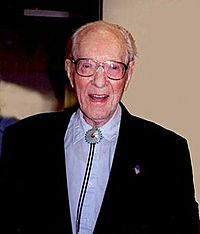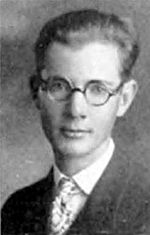Fred Lawrence Whipple facts for kids
Quick facts for kids
Fred Lawrence Whipple
|
|
|---|---|

Fred Lawrence Whipple at age 95 in 2001 or 2002
|
|
| Born | November 5, 1906 |
| Died | August 30, 2004 (aged 97) |
| Nationality | American |
| Known for | Composition of comets, Whipple shield |
| Awards | |
| Scientific career | |
| Fields | Astronomy |
| Institutions | Harvard College Observatory |
| 1252 Celestia | 19 February 1933 | list |
Fred Lawrence Whipple (born November 5, 1906 – died August 30, 2004) was a famous American astronomer. He worked at the Harvard College Observatory for over 70 years! He is known for discovering asteroids and comets. He also came up with the "dirty snowball" idea for comets. Plus, he invented a special shield called the Whipple shield.
Contents
Discovering Fred Whipple's Life and Work
Early Life and Education
Fred Whipple was born on November 5, 1906. His family lived in Red Oak, Iowa. When he was young, he got sick with polio. This meant he could not become a professional tennis player.
Whipple went to Occidental College in Southern California. Then, he studied mathematics at the University of California at Los Angeles (UCLA). He finished his degree in 1927. He later said that math led him to physics and then to astronomy. Astronomy was a perfect fit because it combined time, space, math, and physics.
After taking an astronomy class, he went to the University of California, Berkeley. He earned his PhD in Astronomy there in 1931. While he was a student, he helped map the path of Pluto. Pluto was a newly found dwarf planet at that time.
Amazing Discoveries and Inventions
In 1931, Fred Whipple started working at the Harvard College Observatory. He studied how meteors move. He proved that meteors come from inside our Solar System. They do not come from far-off space.
In 1933, he found a special comet called 36P/Whipple. He also discovered an asteroid named 1252 Celestia. He found five other comets too. One of them was C/1932 P1 Peltier-Whipple. He found it at the same time as another astronomer, Leslie Peltier.
During World War II, Whipple invented something very clever. It was a device that cut tinfoil into small pieces called chaff. This chaff was used to trick enemy radar. He received an award for this invention in 1948.
He also invented the "meteoroid bumper," or "Whipple shield." This shield helps protect spacecraft. It breaks up tiny space particles before they can damage the spacecraft.
The "Dirty Snowball" Comet Idea
From 1950 to 1977, Whipple was an astronomy professor at Harvard University. He was the Phillips Professor of Astronomy for some of those years. In the early 1950s, he wrote important papers called A Comet Model.
In these papers, he shared his "icy conglomerate" idea for comets. This idea later became known as the "dirty snowball" hypothesis. It means that comets are mostly made of ice mixed with dust. Scientists later confirmed that this idea was mostly correct. However, they are still studying exactly how much ice is in a comet. Some new information suggests comets might be more like "icy dirtballs" with less ice.
Whipple also thought about the future of artificial satellites. He organized groups called Operation Moonwatch to track them. These groups were the only ones in the U.S. ready to watch when the Soviet Union launched Sputnik I in 1957.
From 1955 to 1973, he was the director of the Smithsonian Astrophysical Observatory.
Fred Whipple also appeared in a science movie called Target...Earth? in 1980. He was also on the BBC when the Giotto spacecraft met Halley's Comet in 1986.
Fred Whipple passed away in 2004 when he was 97 years old.
Awards and Honors
Major Awards
- President's Award for Distinguished Federal Civilian Service from U.S. President John F. Kennedy (1963)
- Leonard Medal of the Meteoritical Society (1970)
- Golden Plate Award of the American Academy of Achievement (1981)
- Gold Medal of the Royal Astronomical Society (1983)
- Bruce Medal of the Astronomical Society of the Pacific (1986)
- Henry Norris Russell Lectureship of the American Astronomical Society (1987)
- Whipple Award of the American Geophysical Union (1990)
Special Recognitions
- Elected to the American Academy of Arts and Sciences (1941)
- Elected to the American Philosophical Society (1956)
- Elected to the United States National Academy of Sciences (1959)
Named After Him
Many things were named in honor of Fred Whipple:
- The main-belt asteroid 1940 Whipple
- The Whipple Observatory on Mount Hopkins in Arizona
- The Whipple shield (which he invented!)
- Whipple House on Great Camanoe in the British Virgin Islands
Images for kids
See also
 In Spanish: Fred Lawrence Whipple para niños
In Spanish: Fred Lawrence Whipple para niños




